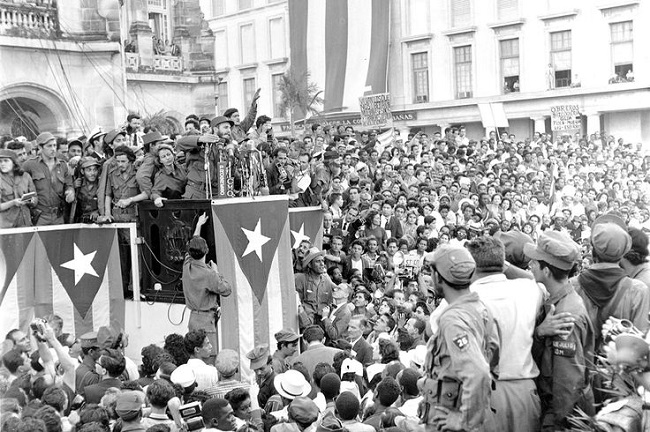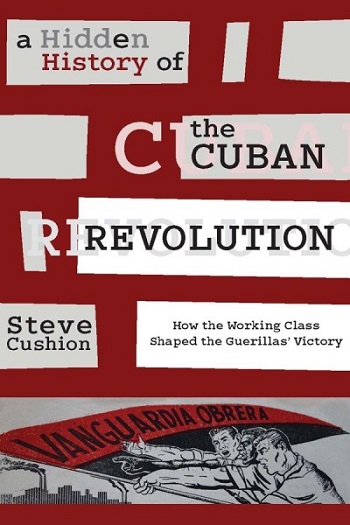
Reviewed: Hidden History of the Cuban Revolution: How the Working ClassShaped the Guerillas’ Victory. By Steve Cushion. New York: Monthly Review Press, 2016. 263pp, $23.00
Here is a volume offering great surprise, at least to this presumably well-educated reader, deeply sympathetic to the Cuban Revolution since its inception or at least since a rollout of toys for Christmas 1959 included some kind of Fidel costume (quickly dropped, thereafter, or did they send those props to the East Bloc?). The author of Hidden History, a retired British professor who worked in factories for considerable periods of his life, seems equally surprised. Perhaps, he opines, the cult of the personality around Che and Fidel is the reason for an absence of real social history on this vital subject? We suspect otherwise, but our suspicions hardly detract from our fascination. The material analyzed here is new and essential to any understanding of Cuban revolutionary history.
Cushion gives us a blow by blow account of the last years and months leading up to the fall of Batista, as well as some valuable decades of backtracking. The Communist party had been heavily involved with the Cuban working class (by any measure, the largest in the Caribbean) since the 1920s, often blundering in its leadership by seeking to turn the class struggle into political gain in offering olive branches to the dictatorial state. The followers of Fidel, and Fidel himself, were, by contrast, up in the mountains mostly during the 1950s, until a foothold was secured in the cities. Thus these two would-be revolutionary entities—CP and guerillas—existed side by side, even if they did not respect or even like each other. They were clearly in competition, across a wide spectrum of issues and campaigns. But facing severe repression, they found ways to get along and even, towards the end, coordinate to an extent. How the necessity of gaining Russian support against the American invasion plans reshaped the Cuban regime in the era to follow is not the subject here, although this book makes us wonder at the subsequent changes, and the personal as well as political complications of internal conflicts that no outsider is ever likely to fully understand.
 The details are thick here, in any case, and much as Cushion (coming from a Trotskyist political background) would like to point to a tradition of revolutionary politics to the left of the CP, he can only find a handful of heroic leaders, now and then, of significance. There’s a story, and not only in Cuba.
The details are thick here, in any case, and much as Cushion (coming from a Trotskyist political background) would like to point to a tradition of revolutionary politics to the left of the CP, he can only find a handful of heroic leaders, now and then, of significance. There’s a story, and not only in Cuba.
One cannot speak of a European-style or even US-style Left lineup here. Marxist parties had only the most tenuous foothold anywhere in the Anglophone Caribbean, the zone that I happen to know best. Marxist ideas influenced mass movements only through individuals and leadership groups in unions and socialistic parties during periods of struggle, of which Guyanese history offers the most impressive and ultimately disappointing example. At times and places, the followers of Marcus Garvey were actually more influential in offering popular visions of some kind of revolution. The odds facing anyone to the left of the Communists were even greater. In Cuba, the CP was both obstacle and yet, in many respects, an inevitable vehicle. The last major figure in the Ybor City (Tampa) CP swore to me, in the early 1980s, that a young Fidel, visiting on a fundraiser in Tampa, thirty years earlier, was ignorant of Marxism and needed a stern lesson in Marxism (my interviewee, secretary-treasurer of the collapsing CP branch, gave him the lesson, along with cash). We may wonder. Fidel, himself of comfortable background, was known to play a careful chess game—or perhaps better said, pitch baseball carefully watching strengths and weaknesses in his own lineup and those of his opponents. That he could play that game attests to his brilliance and tactical flexibility, but also to the special characteristics of the region.
Cushion himself is naturally an outsider to all this, but so industrious is his research, so determined his effort to cast aside previous narratives that he offers us an array of insights and precious details. He knows the saga of sugar production well, its rise and fall with competition from the sugar beet. By 1925, Cuba was the leading cane sugar producer in the world, about to be undercut in several ways. US ownership of the fields became US ownership of the banks that owned the fields, and practically everything else of value on the island. The concentration of sugar workers but also of assorted trades in the Cuban cities brought the labor movement forward, despite repression. Batista lost power, then regained it through a coup, as US investors celebrated too soon. Mass strikes broke out in 1955, from transport to banks to offices (with significant female participation), and the strikers were joined by students. Cushion is particularly keen in showing how the efforts to reduce the sugar and cigar workforce with mechanization mostly fell apart, and with disruptions proved too expensive. Continuous confrontations persuaded workers that more drastic changes were needed.
The subsequent history is so rich with details, the author’s reading of the available literature so obviously intensive and thoroughgoing, that any attempt to summarize would be foolish. It is enough to say that Cushion’s analysis of the Cuban trade union bureaucracy, the ambivalent role of the Communist Party and the continual surprises to all sides as revolution approached, will educate and probably astound almost anyone interested in the Cuban Revolution. There are bound to be useful criticisms of this book, but reader, give it a try. You won’t be sorry.
Paul Buhle is the authorized biographer of C.L.R. James and his Antiguan disciple Tim Hector. An aging, erstwhile new leftist who published the journal Radical America for SDS, Buhle still looks to the Caribbean with great hopes.
